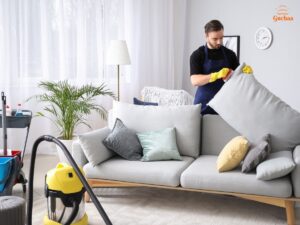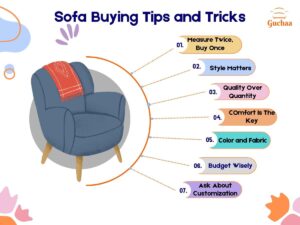
The Ultimate Furniture Buying Guide
Buying a new furniture for your living space is an exciting process. It transforms the look of your

Your sofa is an important part of your home, offering both comfort and style. Identifying the significance of sofa maintenance is key to ensuring its long-term durability and preserving the overall aesthetic of your living space. Beyond enhancing the visual appeal, regular care contributes to the longevity of your sofa. It protects your investment and avoids costly replacements. By addressing issues and adopting a proactive approach to cleaning and maintenance, you can extend the lifespan of your sofa and create a healthier indoor environment for yourself and your family
In furniture care, common misconceptions can misguide well-intentioned individuals, leading to improper care for their cherished items. Misunderstandings rooted in assumptions or oversimplifications can harm the longevity and appearance of our furnishings. Let’s shed light on the potential traps of adopting these misguided beliefs. By clarifying these myths, we aim to certify individuals with the knowledge needed to provide the best possible care for their cherished pieces of furniture. Time for a closer look:
Needing low maintenance for leather sofas is a general misconception. Many assume that the natural durability of leather makes it immune to wear and tear. This misconception overlooks that. Ignoring regular maintenance may lead to the gradual accumulation of dirt, oils, and moisture. It reduces the sofa’s luster and causes long-term damage, such as cracks or discoloration. For example, leather sofas are the primary choice for office sofas. Its frequent use in the office means it needs higher maintenance. So, it depends on where your sofa is placed. However, this idea ignores an important fact.
Contrary to the myth, leather sofas demand regular care to preserve their luxurious appearance and longevity. Routine cleaning is essential to remove surface dirt and prevent it from settling into the pores of the leather. Additionally, conditioning helps maintain the natural oils in the leather, preventing it from losing its elasticity and developing cracks. By incorporating these practices into your sofa maintenance routine, you enhance the aesthetic appeal of your leather sofa and contribute to its overall health and durability.
The belief that cleaning all types of sofas with the same method is another common misconception in sofa care. This myth ignores the diversity of materials in sofas and their unique care needs. A one-size-fits-all cleaning approach neglects material variation, risking ineffective cleaning, color fading, or sofa damage.
Sofas come in various upholstery materials, including fabric, leather, microfiber, and synthetic blends, each demanding distinct care strategies. Fabric sofas, for instance, can be sensitive to water and may require specific cleaning solutions. Leather sofas, on the other hand, benefit from conditioning to maintain their natural oils. Microfiber sofas often require gentle cleaning to avoid disrupting their delicate fibers. Recognizing these differences is crucial to preserving the integrity and appearance of the sofa over time.
There’s a common misconception that regular vacuuming alone is sufficient for keeping sofas clean. Vacuuming is essential for surface dust but neglects deeper dirt, allergens, and stains that build up over time. Relying only on vacuuming neglects the need for more comprehensive cleaning methods to ensure a hygienic and aesthetically pleasing sofa.
Deep cleaning is important for maintaining your sofa’s overall cleanliness and hygiene. Over time, dirt, oils, and allergens can penetrate beyond the surface, contributing to an unhealthy indoor environment and affecting the sofa’s appearance. Additionally, addressing stains quickly is vital to prevent them from becoming permanent and compromising the fabric or upholstery.
The belief that sunlight does not harm sofas is a general myth many homeowners hold. Many individuals assume that sofas are invulnerable to the effects of sunlight exposure. However, this misconception fails to recognize the possible risks of long exposure to UV rays. Sunlight can gradually but significantly impact the upholstery, causing fading, discoloration, and even structural damage over time. Ignoring these effects can lead to decreased aesthetic appeal and the premature aging of the sofa.
Long exposure to the sofa in sunlight can harm the upholstery of sofas. Sunlight’s UV rays can fade and discolor fabrics and materials. It is particularly evident in brightly colored or patterned sofas, where the vibrancy may diminish. Additionally, UV rays can contribute to the breakdown of natural fibers. It may weaken the structural integrity of the upholstery. Overexposure can result in irreversible damage, affecting the sofa’s aesthetic appeal and durability.
Sofa maintenance myths often saturate our understanding of how to care for furniture in various settings, such as living rooms, bedrooms, and offices. One common misconception is that only the living room sofa requires regular upkeep, as it tends to be the focal point of daily activities. In reality, bedroom sofas and office sofas also demand attention to ensure longevity. Neglecting these pieces may result in wear and tear, compromising comfort and aesthetic appeal.
Despite what many believe, the idea that furniture in different rooms requires distinct care routines is inaccurate. While the level of use may vary, general maintenance practices, such as routine cleaning and fabric protection, are universally applicable to promote the overall well-being of sofas in any setting.
This myth believes that professional cleaning services are unnecessary and that routine care can be handled using DIY methods alone. Specially for bedroom sofa, as it is less used.This misconception may arise from a desire to minimize expenses or a lack of awareness regarding the depth of cleaning professionals can provide. However, overlooking the value of professional cleaning, one needs to pay more attention to the specialized equipment, expertise, and thoroughness that professionals bring to the maintenance process.
Professional sofa cleaning offers several advantages that may not be achievable through regular at-home maintenance. First and foremost, professionals have access to industrial-grade equipment that can penetrate deep into the upholstery, effectively removing embedded dirt, allergens, and contaminants. Moreover, professional cleaners use specialized solutions tailored to specific upholstery materials, ensuring a thorough yet gentle cleaning process. Beyond cleanliness, professional cleaning also contributes to the sofa’s longevity by addressing potential issues before they escalate into more significant problems.
A common misconception in sofa maintenance is the belief that using many cleaning products will lead to better results. Some assume that great cleaners, sprays, and conditioners will ensure a more thorough and effective cleaning process. However, this misconception overlooks the potential harm of using excessive or incompatible cleaning products on sofas, leading to unintended consequences and damage to the upholstery. It is essential to consult with your furniture shop before utilizing any cleaning products or sticking to the manufacturer’s guidelines.
Overusing cleaning products can result in several adverse outcomes for your sofa. Firstly, certain cleaning agents may contain harsh chemicals that can strip the natural oils from leather or cause color fading in fabric upholstery. Additionally, using multiple products simultaneously may create chemical reactions that could damage the material. So you need to know about do and don’t about sofa cleaning. Therefore, assuming that more products correlate to better maintenance can lead to ineffective and harmful consequences.
Dispelling the myth that all branded sofas guarantee easy maintenance, the reality is more nuanced. While reputable brands often invest in quality materials, it’s crucial to recognize that not all models are equal. The comfort of maintenance depends on factors like upholstery material, and regular care is essential for even the highest-end sofas. When heading to a furniture shop to buy a sofa, inquire about materials, maintenance requirements, and expected lifespan. Taking the time to ask questions and test durability ensures an informed choice, aligning your buying sofas with style preferences and practical expectations for maintenance.
Sunlight can help freshen up the sofas, but more effective methods exist. Proper ventilation, regular cleaning, and using odor-absorbing products are more reliable solutions.
Stain-resistant fabrics offer some protection. But still, they are not foolproof. Quickly cleaning spills and following the manufacturer’s guidelines for stain removal are essential to maintain the sofa’s appearance.
Not necessarily. Depending on the extent of wear, professional upholstery services can often restore and renew a sofa, extending its lifespan and maintaining its aesthetic appeal.
Yes, professional cleaning is important even if your sofa appears clean. Professional services can remove deep-seated dirt and allergens that regular cleaning may not address, promoting a healthier indoor environment.
The lint rollers are helpful but may not capture all pet hair. Consider using a vacuum cleaner with a pet hair attachment for more thorough removal.

Buying a new furniture for your living space is an exciting process. It transforms the look of your

In today’s modern interior design landscape, Rexine has appeared as a trendy and cost-effective alternative to genuine leather

Sofa is an important piece of furniture in any living space. But, outliving the daily severities of family

A sofa is the most used furniture piece in the living space. It has to bear various wear
Feel free to drop us a message if you have any inquiries or suggestions regarding our products or services. We’re here to assist you, and we’ll promptly respond to your message. Thank You.